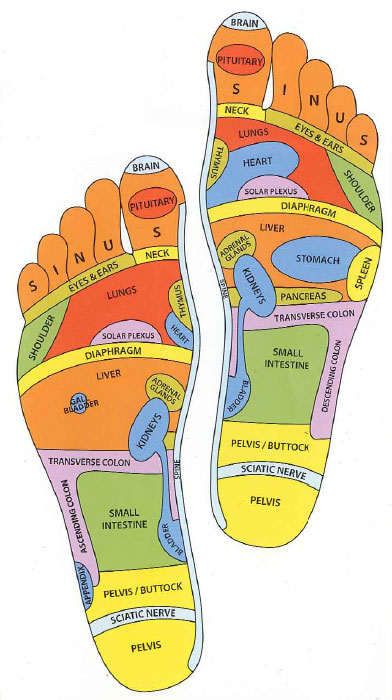Reflexology 101: Not Just a Foot
While most people think that reflexology is just another word for foot massage, it is in fact much more than that…but what exactly is it and what does it do?
 Beyond the feel-good effects of the treatment, the practice and purpose go deeper than the skin and muscles by taking specific reflex points on the foot to induce a healing response in corresponding organs and areas of the body, as seen in the chart to the left. Kneading the soft fleshy ball of the foot, pulling on the toes, tracing around the heel and pushing deep into the arch are just a few of the many small, intense movements you’ll experience during a reflexology treatment.
Beyond the feel-good effects of the treatment, the practice and purpose go deeper than the skin and muscles by taking specific reflex points on the foot to induce a healing response in corresponding organs and areas of the body, as seen in the chart to the left. Kneading the soft fleshy ball of the foot, pulling on the toes, tracing around the heel and pushing deep into the arch are just a few of the many small, intense movements you’ll experience during a reflexology treatment.
Addressing anything from headaches to sinus problems to stomach issues, if sensitivity or tenderness is experienced when certain areas of the foot are stimulated, it usually indicates bodily weaknesses or imbalances within the corresponding organ. With repeated practice of applying pressure and manipulating nerve endings (traditionally in the foot), reflexology can help to clear any channels of blocked energy through moving the flow of blood, nutrients and nerve impulses to ultimately improve overall health and balance. In addition to manipulating the pressure points on the foot, reflexologists sometimes work on the hands or ears to trigger relaxation as well.
The Benefits:
- Cleanses the body of toxins
- Boosts the immune system
- Increases circulation
- Promotes healing
- Balances energy
At the Spa:
To be effective, a reflexology practitioner must be certified and understand the meridians related to each pressure point. Most spas offer reflexology, and the treatment typically lasts approximately 30 minutes. It’s important to have a conversation with your reflexologist beforehand to discuss your “issues,” whether it is constipation, a tension headache or trouble sleeping.
During a reflexology session, you’re clothed and seated or lying down while the therapist rubs, presses on and squeezes points on your feet. The therapist may concentrate on specific areas to alleviate ailments (if you have sinus trouble, she’ll focus on your toes) or work on the whole foot with the aim of strengthening every system in the body.
Things to Remember:
- Wait at least one hour for massage after eating
- Don’t receive reflexology if you are pregnant
- Drink water following the treatment to eliminate toxins and lactic acid buildup that occurs during the massage
- Consult a doctor first if you have foot problems, an injury, a blood vessel disease associated with clots or varicose veins
For more information on reflexology and other massage treatments, check out our Massage Guide. Also, search for spas that offer reflexology in your area by entering your zip, city, state or country to specify a location.
To read more about the medical evidence surrounding various other spa therapies, check out Wellness Evidence.
